HTIRC E-NEWSLETTER
Fall and Winter 2020
Volume 12 Issue 2
Articles in this issue
- Butternut Canker Resistance Breeding Progress – New Selections 2020
- Oak and Fire Research Summary
- Unmanned Aerial Systems- The next gen technology for Digital forestry!
- The microbiome of walnut trees may explain regional differences in Thousand Cankers Disease severity
- Agriculture Lectures Inspire Future Engineers
- Dr. Anna Conrad joins the HTIRC as Research Plant Pathologist
- HTIRC Annual Meeting Highlights Research Reports and Center Activities
- Plantation Management Webinars Online
- Dr. Lawson’s Research into Walnut and Soil Relationships Highlighted by US Forest Service
- HTIRC Partners with Industry and other Centers to Expand Research Opportunities
Butternut Canker Resistance Breeding Progress – New Selections 2020
James McKenna, Operational Tree Breeder
New Selections: We measured and evaluated our second butternut canker disease (BCD) screening block last winter and identified nearly 40 new potential resistant selections. Of those, we collected scion wood in January of the 15 most promising individuals and grafted them onto black walnut rootstock (J. nigra). In addition, we collected scionwood from another 15 clones from our first screening block, selected nearly a decade ago, that are growing in an isolated orchard in northern Indiana. This orchard has been making seeds for the last three years and we selected 15 of the highest seed-yielding clones to graft and to augment with these new selections. All 30 selections are split between pure butternut (Juglans cinerea) and naturally occurring hybrid butternut which contain varying amounts of Japanese walnut (J. ailantifolia) germplasm which have more resistance to BCD than pure butternut. These successful grafts will be made available among our HTIRC cooperators to establish new isolated second-generation resistant breeding orchards. The progeny from that orchard and these new ones will be screened again for BCD resistance and butternut form and growth, and the most resistant and desirable individuals will be selected as a source of BCD resistant butternut for the Central Hardwood Forest Region later this decade.
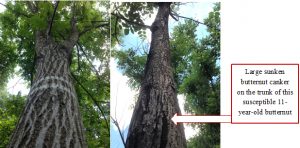
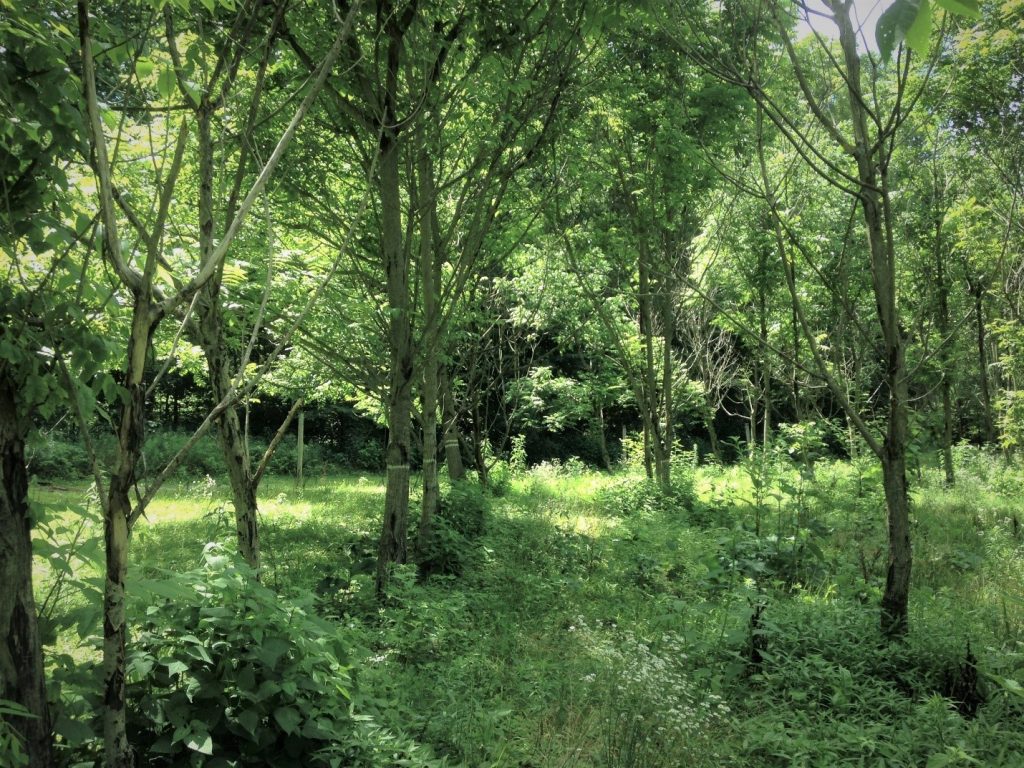
Figure 2. Surviving progeny in our second HTIRC BCD screening block. A resistant hybrid family has 3 of 4 seedlings still alive and healthy (white rings) while most neighboring families have died or been thinned out due to severe BCD.
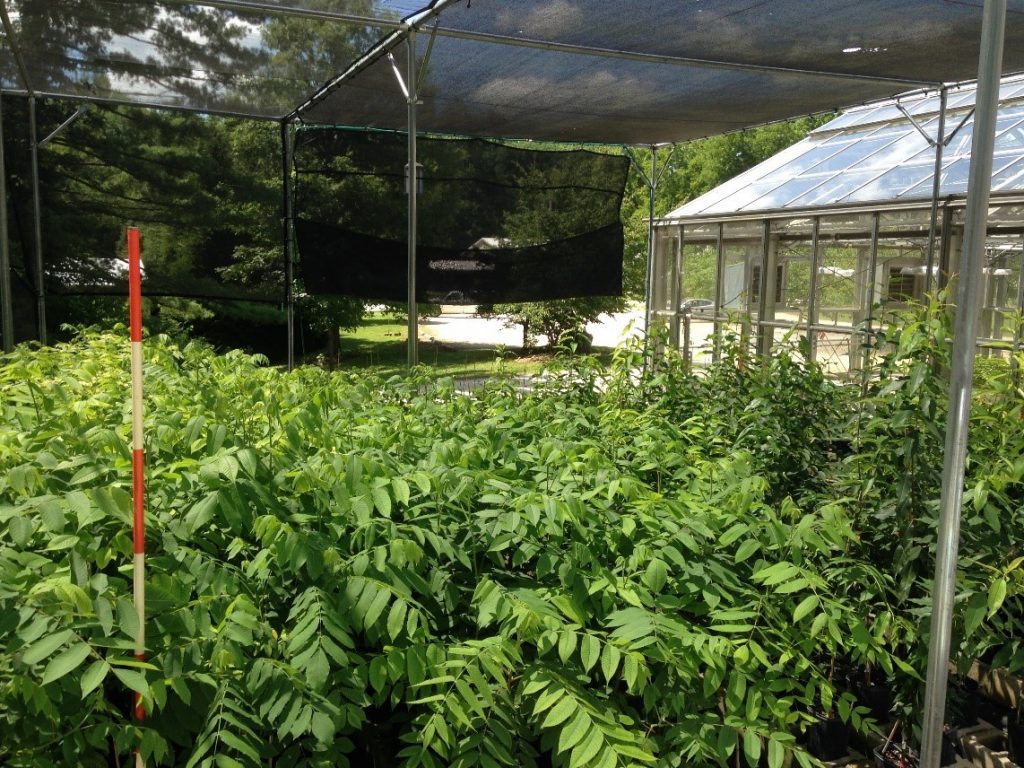
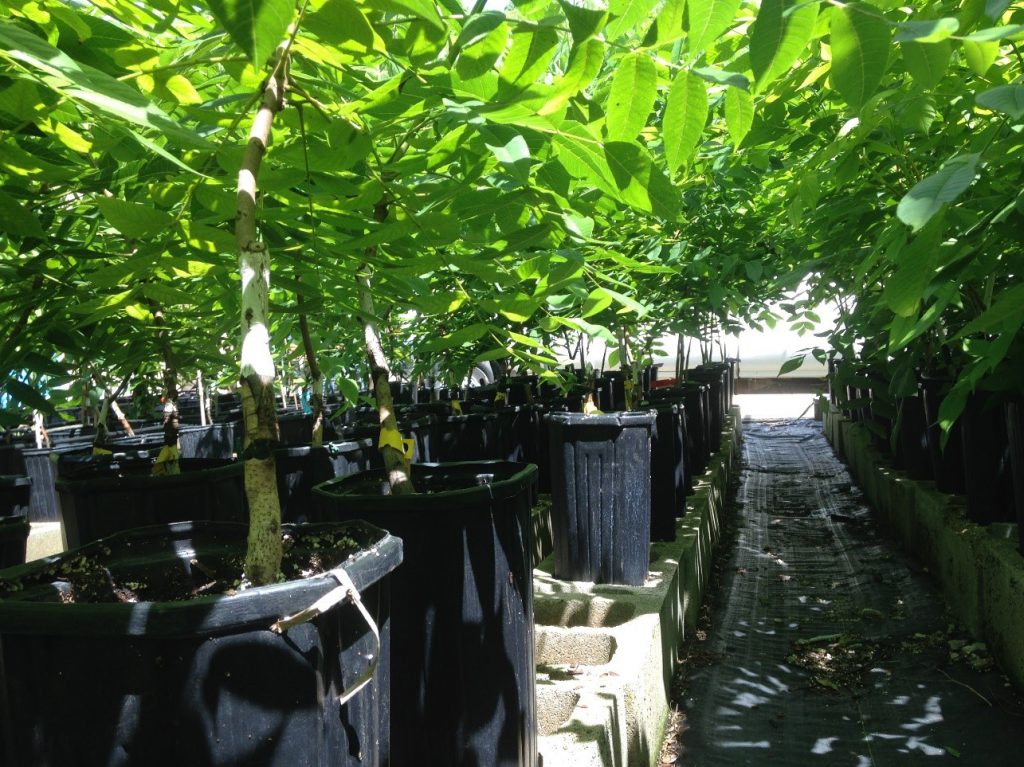
Oak and Fire Research Summary
Sarah Cuprewich, MS Student and van Eck Scholar with Dr. Saunders
We are researching the direct and indirect effects of prescribed surface fire on oak (Quercus) regeneration. Our study consists of two components. First, we are determining if there is a minimum number of repeated prescribed fires that must occur to selectively benefit oak regeneration and growth. This study inventories oak regeneration on burned and unburned sites in both the Hoosier (HNF) and Wayne (WNF) National Forests, quantifying the number and size of all seedlings, other groundcover, and midstory species. Last summer, we inventoried 37 sites in the HNF and 9 sites in the WNF. We plan to expand the sample in Summer 2020 to another 20-40 sites both on the HNF, the WNF, and potentially the Daniel Boone National Forest in Kentucky. Our observations have been consistent with other studies. We observed absent or reduced midstories at sites that were burned 3 or more times (Figure 1), and abundant oak seedlings <3 ft tall at less frequently burned sites. Maples (Acer) were commonly the most abundant midstory species, but oaks dominated in the overstories. On unburned sites we recorded a mean of 170 seedlings/acre, while on burned sites, there was an average of 200 seedlings/acre. Both burned and unburned control stands contained on average 18 tree species.
Second, we are determining how prescribed surface fire may affect underground symbiont communities that promote oak regeneration. We are collecting truffles in burned and unburned stands at the Hardwood Ecosystem Experiment. Truffles are the fruiting bodies of some species of endo- and ectomycorrhizae (AM and EM, respectively), which make associations with nearly all the tree species located in the Central Hardwood Region (CHR). We hypothesize that the obligate relationship with their symbionts changes with increasing numbers of prescribed fire. Quercus species are most commonly EM, while their understory competitors Acer are mostly AM.
The differential effects of fire on the host species to prescribed fire may lead to differential survival among AM and EM species after fire. Furthermore, trees with EM associations often have better seedling recruitment than AM trees, partially through a higher carbon investment from the tree to the EM fungus. From past research, regenerating oaks need EM relationships to be competitive and successfully grow into the overstory; therefore, after severe disturbances (e.g., harvesting), EM and AM species need to be present in the soil. Small mammals help in this regard, as they an important consumer of truffles and dispersing agent for the spores. For example, some truffle species germinate only after passing through a digestive tract. Therefore, although prescribed fires may reduce aboveground competition for oak seedlings, they also could impair formation of mycorrhizal relationships either directly (e.g., high fire intensity) or indirectly (e.g., affecting small mammals), thereby stunting future growth potential.
Field work for this study also began this summer. We selected 120 plots across four burn areas and two control stands on the Hardwood Ecosystem Experiment in southern Indiana. In each plot, we first searched for aboveground mushrooms and then sifted through the top 10 cm of soil in each plot for truffles (Picture 2). On some of the same sites, chipmunk scat was collected from 66 individuals; these samples are being processed for spore extraction and will eventually be used to identify which fungal species the chipmunks are eating in burned and unburned plots.
Our research will provide information that can be used by land managers to make better decisions regarding the use of prescribed fire for oak regeneration. Managers will better be able to weigh the ecological and economical costs and benefits of prescribed fire. We will also gain fundamental knowledge of truffle communities and the impact of fire on those communities, a significant knowledge gap for the hardwood forests of the CHR.
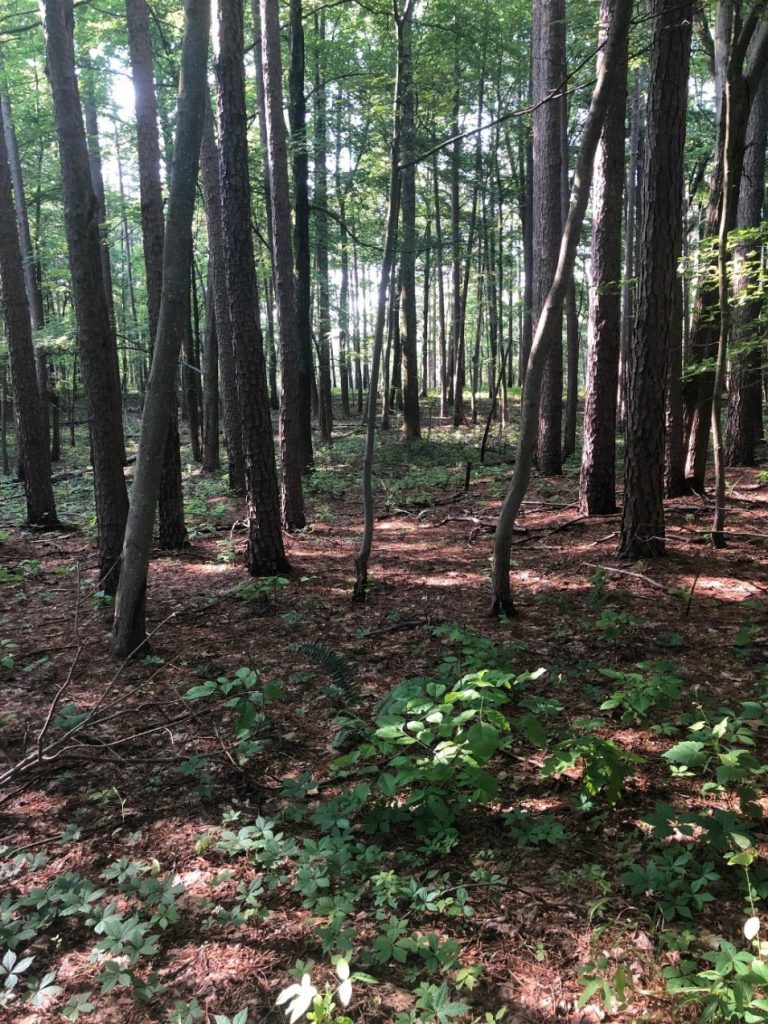
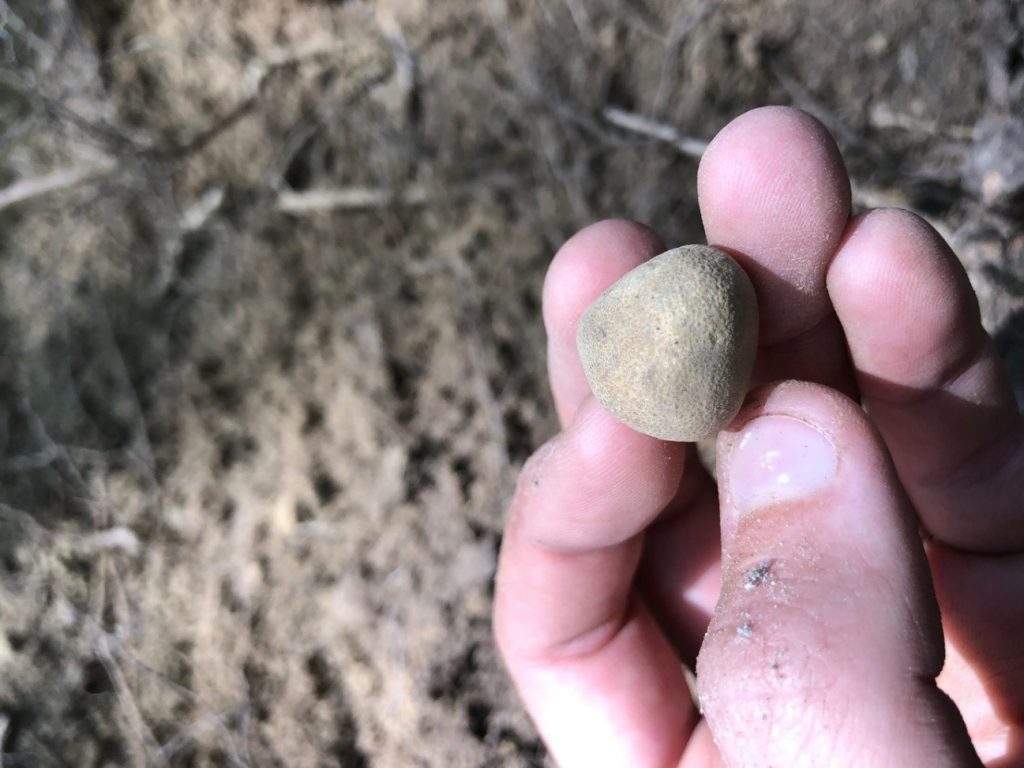
Unmanned Aerial Systems- The next gen technology for Digital forestry!
Aishwarya Chandrasekaran
Representing forest information through a digital format is preferred by forest managers and researchers for its ease of access and use. A lot of focus has been shown towards digital forest inventory maintenance as there is a need for storing repeated measurements. These repeated measurements can be used to track tree growth, its health condition and help with management decisions. Multiple modes of platforms are being tested for repeated forest measurement. One of them being LiDAR, an expensive technology was adopted widely for tree measurement through various platforms like airborne, terrestrial and mobile. Several thousand dollars are needed to assemble a LiDAR platform and sensor, requiring trained professionals for operation. Recently, Unmanned Aerial Systems (UAS) are taking over LiDAR in forestry due to their cost and simple operational procedure.
UAS mode of data collection requires a minimal crew of two people to collect imagery data which can be processed to generate height models that provides a realistic view of a tree. Digital height models are generated using structure from motion (SfM) and dense cloud matching. SfM is a photogrammetric imaging technique that creates 3D structures from 2D imagery using image overlap technique. Using this concept, UAS based 2D imagery can be utilized to construct a three dimensional view of forest structures, which then can be analyzed using various image processing techniques to derive biophysical tree parameters like height, crown diameter and crown area.

Estimating biophysical parameters based on UAS imagery is not an easy task. Numerous methodologies have been tested to derive accurate measurements, most of them being site-dependent. We developed a web based application that will derive individual tree parameters when supplied with height models like Digital Surface Model (DSM) and Digital Elevation Model (DEM). These height models can also be derived from LiDAR point clouds and supplied to the application. This web application is a simple 3 click Shiny application (RStudio) which can be accessed at https://feilab.shinyapps.io/Crown/ developed for users to get tree level information for their area of interest.
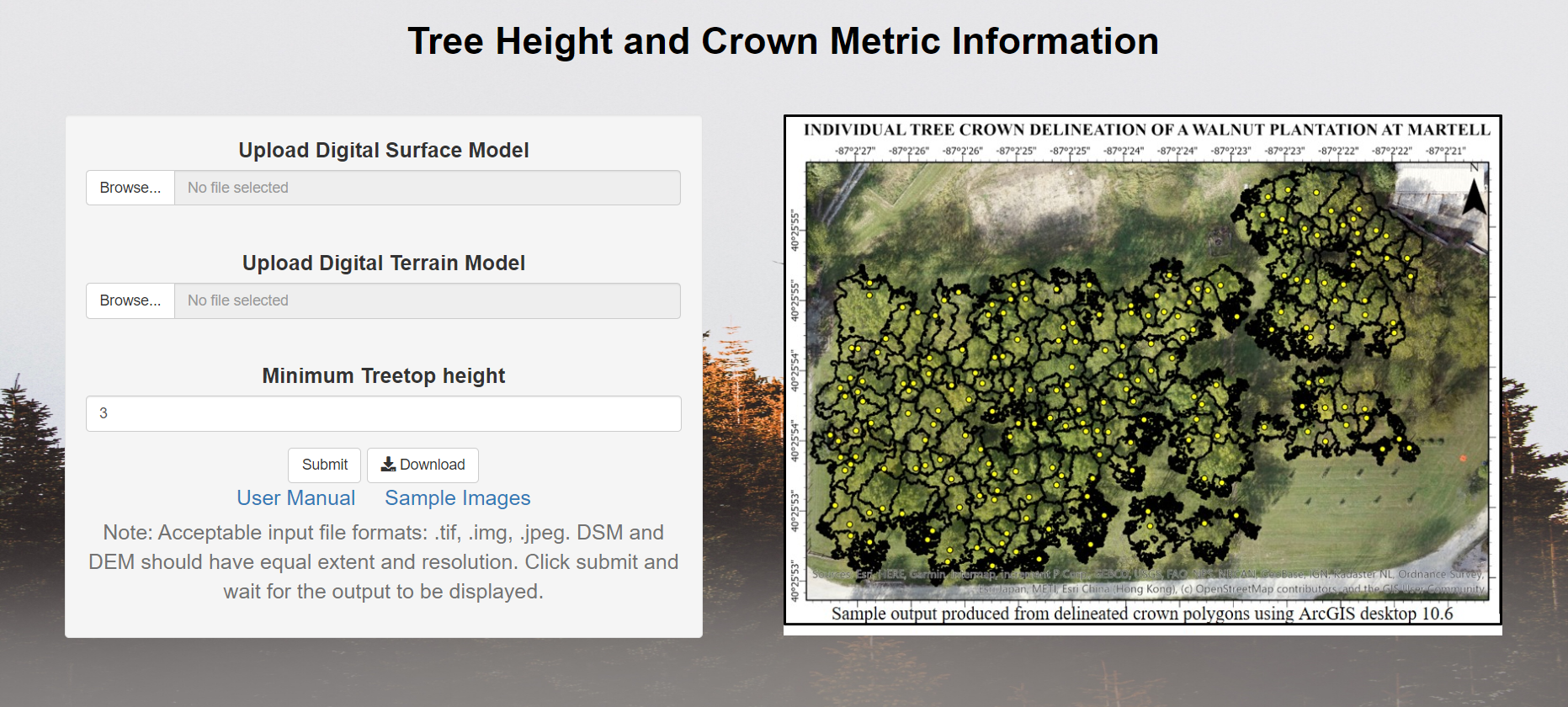 Figure 2. Outlook of the Web based application developed for forest tree measurement using ShinyR.
Figure 2. Outlook of the Web based application developed for forest tree measurement using ShinyR.
The microbiome of walnut trees may explain regional differences in Thousand Cankers Disease severity
Geoff Williams, PhD candidate and vanEck Scholar
Thousand Cankers Disease (TCD) of black walnut (Juglans nigra) is caused by a pathogenic fungus called Geosmithia morbida and its vector, the walnut twig beetle (WTB, Pityophthorus juglandis). Together, large populations of WTB and G. morbida critically damage the cambium, causing rapid, widespread death of eastern black walnut throughout the western U.S. TCD threatens the health and productivity of black walnut in the Central Hardwood Forest Region (CHFR). However, the rate of spread and the level of severity of TCD are variable, and disease pressure has been low within the native range of black walnut in the East. In fact, some with affected trees in Tennessee and Virginia have recovered from the disease.
Starting in 2017, HTIRC Director Dr. Matt Ginzel, collaborators at the University of Tennessee-Knoxville and Oak Ridge National Laboratory, and graduate students Aaron Onufrak (UT-Knoxville) and I embarked on a quest to learn about the relationship between TCD and the rest of the host microbiome. The microbiome refers to over three thousand species of fungi and bacteria from branches, and nearly thirty thousand species of fungi, bacteria, and archaea living in the soil around the base of black walnut trees that we detected from DNA sequence data in our study. When they interact with one another in the same habitat, these diverse microbes are referred to as a community.
We hypothesized that in addition to other environmental factors, the host microbiome could partly explain differences in the severity of TCD between Washington, Tennessee, and Indiana in four different grafted HTIRC accessions of black walnut that were planted in these locations, as well as non-grafted, open pollinated trees. There is a much longer history of black walnut in the East compared to the West. Black walnut was only planted west of the Great Plains within the past 200 years, while associations between diverse, rapidly-reproducing microorganisms in the soil and the branches of black walnut trees in the CHFR have been shaped by millions of years of evolution. Therefore, we wanted to know the extent to which differences in TCD severity between the eastern and western U.S. could be driven by novel interactions with pathogens, or loss of interactions with beneficial microbes that help defend the tree from disease or provide other functions to the host in the native range.
Our findings, published in Phytobiomes Journal (American Phytopathological Society) suggest that differences in the host microbiome could be partly responsible for observed regional differences in TCD severity. Richness, or the number of different species of branch bacteria, soil bacteria and fungi was much lower in Washington, outside the native range of black walnut. Richness was highest in Indiana where TCD has not been found, and intermediate in Tennessee, where TCD emerged in 2010 but subsequently subsided. Interestingly, within the native range (IN and TN) there was higher richness of mycorrhizal associations in soil and potentially beneficial fungi that parasitize other fungi in branches.
We also found interesting patterns in beta-diversity, or differences in the composition of the bacterial and fungal communities among locations and host genotypes. The makeup of the whole microbial community, as well as the composition of beneficial and pathogenic fungi, was distinct among trees in Washington compared to Indiana and Tennessee. Furthermore, the microbiome was dominated by different taxonomic groups in a way that correlated with the increasing severity of the disease. Interestingly, communities from non-grafted trees in Tennessee were more similar to grafted and non-grafted Indiana trees than they were to grafted trees in Tennessee. We also found that pathogenic fungi in the branches differed between HTIRC clones and that some plant pathogens and antagonists of plant pathogens were indicator species for TCD-positive and TCD-negative trees, respectively.
We also had some unexpected results that suggest that the microbiome of black walnut may change in response to infection with TCD. G. morbida was associated with a distinct microbiome in branches in Washington that was very different compared to healthy branches in the same location. These findings extend our knowledge of how the host microbiome interacts with diseases and wood-boring insects, and may partly explain why TCD is more severe outside of the native range of eastern black walnut. Ongoing and future work at the HTIRC will continue to shed light on the predisposing factors that make forest trees more vulnerable to attack by insect pests and pathogens.
Citation for article:
Aaron J. Onufrak, Geoffrey M. Williams, William E. Klingeman III, Melissa A. Cregger, Dawn M. Klingeman, Jennifer M. DeBruyn, Matthew D. Ginzel, and Denita Hadziabdic 2020. Regional Differences in the Structure of Juglans nigra Phytobiome Reflect Geographical Differences in Thousand Cankers Disease Severity. Phytobiomes Journal Online First.
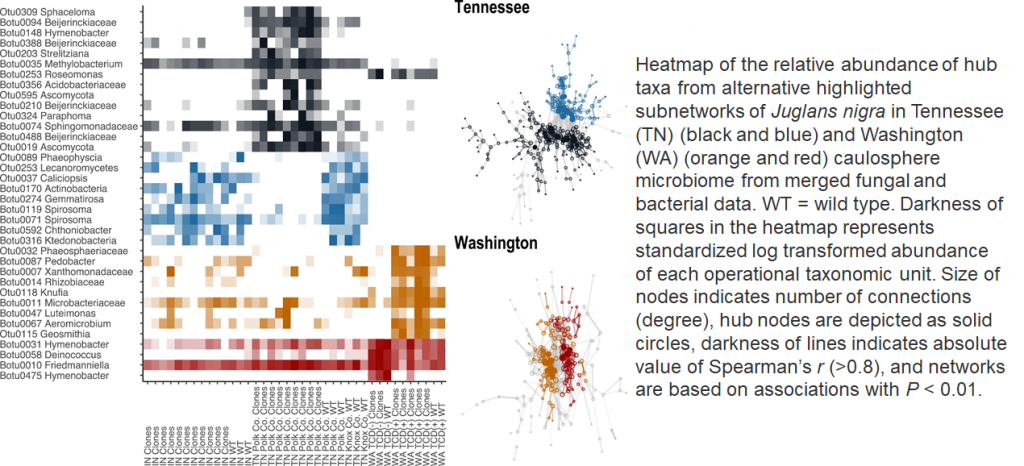
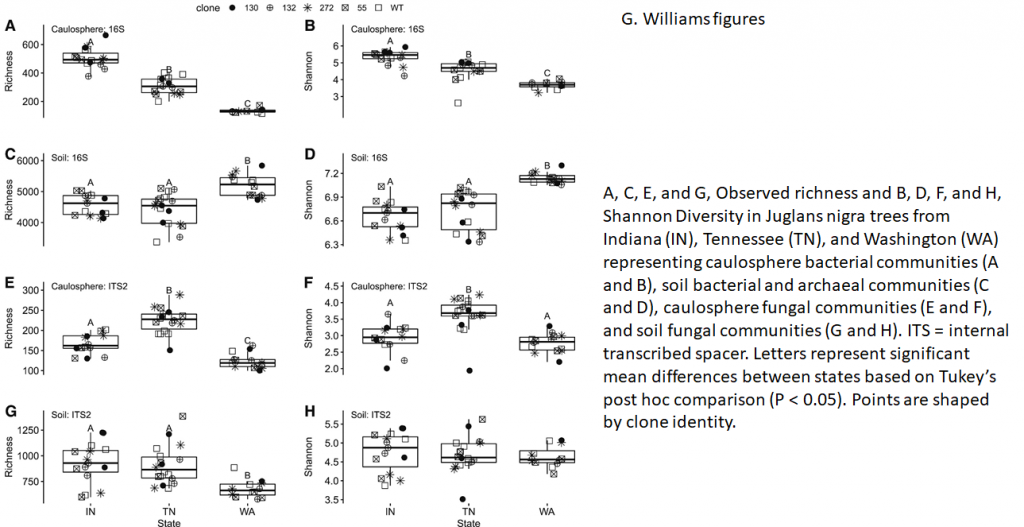
Agriculture Lectures Inspire Future Engineers
Dr. Shaneka Lawson has been working with Purdue Polytechnic High School to enhance their high school programming. Recently, the learning modules at the school began to include aspects of Agriculture and Forestry. Dr. Lawson was contacted by organizers of the program and asked to travel to their Indianapolis, IN classroom location to share lectures regarding growth and development of fruit and nut trees. She was then asked to relate these practices to common agriculture row crops and the marketing of these food products within the United States. One student stated “It was thrilling to hear how a walnut went from a tree in a greenhouse to my favorite ice cream topping in the grocery store!” When giving the lectures, Dr. Lawson added sections with details about numerous of other food crops with specifics about the various countries wherein they are grown most prevalently. These lessons were not just informative; they were formatted to provide baseline information to the students so that they could then begin thinking about an area to focus on for their class projects. These students were envisioning designs for submission to an agricultural engineering competition to be held at Purdue. The design ideas ranged from a new harvesting apparatus for walnuts to development of a new aquaponics method for growing potatoes in towers rather than in the ground. The students came up with innovative ideas and great majority of the students in the group expressed an interest in pursuing a career in the field so that they can come up with “new and improved” inventions to assist in the growth and harvesting of agriculture crops and nut trees.
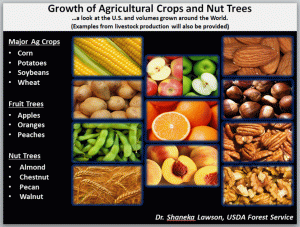
Dr. Anna Conrad joins the HTIRC as Research Plant Pathologist
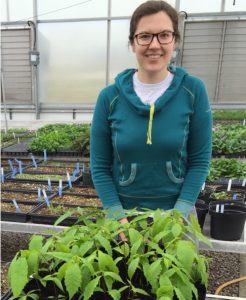
Dr. Anna Conrad, Research Plant Pathologist with the USDA Forest Service Northern Research Station joined the HTIRC in August 2020.
Dr. Conrad’s research uses knowledge of the mechanisms underlying tree-pathogen interactions to develop practical, field-deployable tools for improving forest health. She is interested in understanding mechanisms of resistance in trees and using that information to develop more rapid phenotyping tools to facilitate resistant tree breeding and disease management.
Dr. Conrad received a BS in Environmental Biology from SUNY College of Environmental Science and Forestry, Syracuse, NY in 2010. An interest in plant-fungal-insect interactions as an undergrad led her to a career in plant pathology. In 2015, she received a PhD in Plant Pathology from The Ohio State University, Columbus, OH. As a PhD student, Dr. Conrad’s research focused on understanding and predicting resistance in oak to Phytophthora ramorum, the causal agent of sudden oak death. Following her PhD, Dr. Conrad joined the Forest Health Research and Education Center at the University of Kentucky as a Postdoctoral Scholar, where she worked on a variety of projects, ranging from dormancy in fruit trees to chestnut blight. She then returned to Ohio State as a Postdoctoral Researcher in 2017 where she focused on developing spectral based tools for identifying disease resistant trees and for early disease detection.
In addition to conducting research, Dr. Conrad enjoys working with and mentoring students and giving guest lectures on plant pathology-related topics, especially tree diseases. She is a member of the American Phytopathological Society and served as the Chair of the Forest Pathology committee from 2018 – 2019.
HTIRC Annual Meeting Highlights Research Reports and Center Activities
The HTIRC Advisory Committee and HTIRC faculty, students and staff met virtually on October 13th to hear reports on progress towards the goals outlined in our strategic plan. Presentations on HTIRC funded research projects were provided by seventeen graduate students, postdocs, and faculty. Updates were also provided on tree improvement and outreach activities and our participation in the Center for Advanced Forestry Systems research partnership.
The Advisory Committee provides direction and oversight to help HTIRC address real issues with research and education directed at hardwood tree planting and management. Become more familiar with the Advisory Committee, staff, and strategic plan at our website: https://htirc.org/
Plantation Management Webinars Online
In July the Walnut Council, in partnership with HTIRC staff, hosted a series of five webinars to provide the latest information on growing hardwood trees, especially walnut. These were recorded and are now available for viewing on YouTube, google “Walnut Council webinars” to locate.
The recorded webinars include topics on:
- Timber Markets (Logan Wells, WI DNR, Matt Yest, Kendrick Forest Products, Brian Brookshire of Missouri Forest Products Association/American Walnut Manufacturers Association
- Thinning my plantation – when and how (Bruce Wakeland, HTIRC advisory committee, IN consulting forester, retired and John Kelsey, WV landowner)
- Where should I plant and manage walnut? – Soils and sites (from the HTIRC, Jim McKenna, operational tree breeder plus Steve Felt, IL DNR)
- Forest health issues- walnut concerns and other pending issues (Fredric Miller, Joliet Junior College)
- Ask the experts- moderated Question and Answer session from the audience. (from the HTIRC, Lenny Farlee, extension forester plus Dave Boyt, MO landowner and Steve Felt IL DNR)
Upcoming webinars
November 17, 3 PM ET: Pruning, TBD
December 15, 3 PM ET: Economic and technical assistance for woodland management, Lenny Farlee, HTIRC Extension Forester
Sign up for monthly webinars here: https://walnutcouncil.org/events/.
HTIRC Partners with Industry and other Centers to Expand Research Opportunities
The Hardwood Tree Improvement and Regeneration Center is a founding member of the Center for Advanced Forestry Systems (CAFS), a partnership between industry and academic institutions to provide support for research that helps answer questions of importance to forest industry and managers. Industry partners, like ArborAmerica and the Indiana Hardwood Lumbermen’s Association, provide financial support, but also guidance on issues needing research to address forest management and product opportunities and problems. “The industrial partnerships are critical to the success of CAFS,” said Matthew Ginzel, a Purdue professor of forest entomology and director of the HTIRC. “CAFS provides a way for us to be more relevant to them by tackling important problems across various institutions that impact the forest industry more broadly.” To learn more about this important partnership you can read the full article here:
New Fire Experiences for HTIRC Alumna Skye Greenler
Skye Greenler received her Master’s Degree researching oak regeneration and fire impacts with the HTIRC. Skye is now working on her PhD in Oregon and having some new and different experiences with fire. You can find out more about the new ways Skye has become acquainted with fire in this article: https://ag.purdue.edu/fnr/Pages/Prescribed-Fire-Research.aspx
Forest Advanced Computing and Artificial Intelligence (FACAI) Laboratory
HTIRC investigators Dr. Jingjing Liang and Dr. Mo Zhou lead the Forest Advanced Computing and Artificial Intelligence (FACAI) Laboratory at Purdue. With the assistance of several postdocs and graduate students, FACAI employs the paradigm of Artificial Intelligence (AI) encompassing different state-of-the-art machine learning and statistical methods to study global, regional, and local forest resource management and biodiversity conservation. To learn more about their team and research visit the lab website at: https://ag.purdue.edu/facai/recent-news/
New Research Uses US Forest Service Inventory to Examine the Fate of Ash Trees
Dr. Songlin Fei and postdoc Dr. Samuel Ward are using the US Forest Service forest inventory to track the fate of ash trees impacted by the invasive emerald ash borer (EAB) over time. They found that ash trees rebound strongly as seedlings and saplings regenerate where larger trees are killed by EAB, but this next generation of ash may be wiped out before it can produce seed. Learn more about this research and it’s implications for ash in the forest at the links below:
Article: (https://www.sciencemag.org/news/2020/09/sparkling-beetle-could-spell-doom-north-america-s-ash-trees
Population dynamics of ash across the eastern USA following invasion by emerald ash borer publication link: https://t.co/Mzrk6OarrK?amp=1
Honors bestowed on Dr. Songlin Fei
Congratulations to Dr. Songlin Fei who was just approved by the Purdue Board of Trustees as the Dean’s Chair of Remote Sensing for the College of Agriculture. Achieving this Chair position is quite an honor as it was very competitive. Details about Dr. Fei and the new Chair can be found at: https://ag.purdue.edu/stories/purdue-names-songlin-fei-deans-chair-of-remote-sensing/
Dr. Fei has also been selected as the recipient of the 2020 Purdue University Agricultural Research Award. This is the highest honor awarded to a mid-career faculty member in the College of Agriculture in recognition of their research accomplishments. Songlin’s outstanding contributions in addressing critical ecological problems have made significant impacts within the state, nationally, and globally. His research excellence in forest ecology, invasion ecology, and geospatial systems also are making valuable contributions in shaping and leading digital natural resources efforts within the College of Agriculture.
Fire and Timber – Measuring the Impacts
Fire is an important tool for managing forests and regenerating ecologically and economically important oak species. Fire can also decrease recoverable log volume and degrade log quality, resulting in economic losses. Dr. Mike Saunders and several graduate students, including Mike Mann, are researching the balance between fire as a management tool and fire damage to tree quality. This recent publication provides some insights into the impacts of fire on timber quality.
Evaluating Economic Impacts of Prescribed Fire in the Central Hardwood Region article link: https://academic.oup.com/jof/article/118/3/275/5813252
Dr. John Couture Provides Insights into the Behavior of an Emerging Invasive Pest
HTIRC investigator Dr. John Couture teamed with several colleagues to explore the habits of a potentially devastation insect pest of several woody plant and tree species. Spotted Lantern Fly is an invasive insect already impacting several eastern states agriculture and forestry sectors, and threatens to spread. Dr. Couture and colleagues are examining the tree preferences and habits of this pest to provide insights on potential monitoring, management and control techniques. You can learn more about this pest and important work here:
Fidelity and Timing of Spotted Lanternfly (Hemiptera: Fulgoridae) Attack Patterns on Ornamental Trees in the Suburban Landscape https://academic.oup.com/ee/advance-article-abstract/doi/10.1093/ee/nvaa109/5909896?redirectedFrom=fulltext
HTIRC investigators exploring forests from different perspectives and with unique approaches are highlighted in this recent article:
https://ag.purdue.edu/envision/the-silent-work-of-forests/
The Passing of a Friend
Scott Brundage has been a fixture on the advisory committee for HTIRC since the beginning. We are saddened to recognize the passing of Scott on August 8, 2020. Scott, a professional forester and graduate of Purdue University, was an enthusiastic and engaged advisor and supporter of HTIRC, and a great friend to many of our members. We express our sympathy to his family and friends and will miss his energy and engagement. More information on Scott’s contributions can be found here: https://htirc.org/wp-content/uploads/2020/08/In-Memory-of-Scott-Brundage.pdf
Dr. Lawson’s Research into Walnut and Soil Relationships Highlighted by US Forest Service
Dr. Shaneka Lawson is conducting an in-depth study of planted black walnut tree sites to investigate how soil characteristics affect tree growth. The results of this research should help planters and managers of black walnut better understand the relationships soils have with walnut performance.
“We are analyzing and evaluating soil nutrient content, water-holding capacities, and microbial community composition in black walnut plantations and seed orchards to see how they impact walnut tree growth,” said Lawson.
This work is funded in part by the HTIRC van Eck research grant program.
You can see the full article here: https://www.nrs.fs.fed.us/featured/2020/10/
New Video products with HTIRC Staff
Concerns and restrictions on in-person meetings and programs has encouraged us to produce additional materials available as online videos. Several HTIRC staff members have contributed to the products highlighted below and produced in partnership with Purdue University Forest Forestry and Natural Resources Extension.
Woodland Stewardship Video Series: https://ag.purdue.edu/fnr/Pages/WoodlandStewardshipForLandowners.aspx
Webinars: https://www.purdue.edu/fnr/extension/webinar/
Ask the Expert Sessions: https://www.purdue.edu/fnr/extension/join-us-live/
